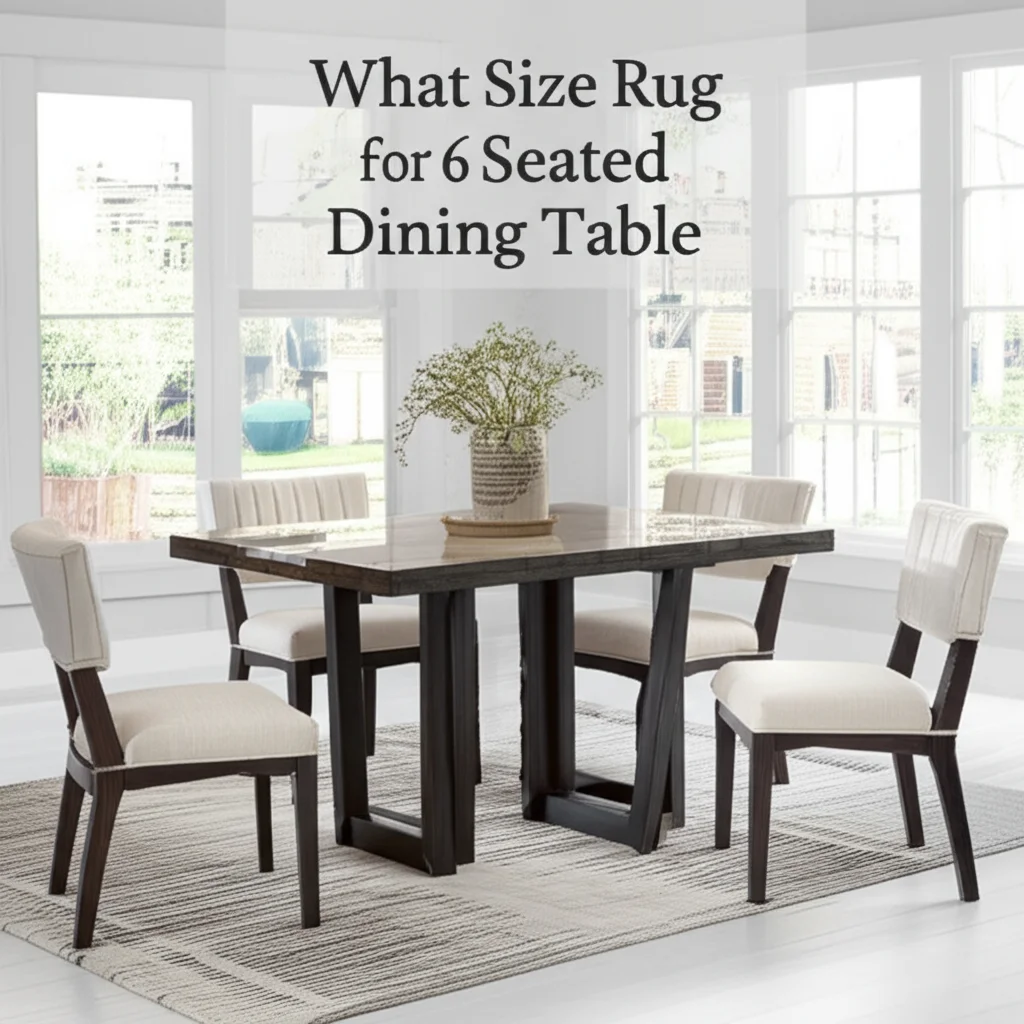· Todd Martin · Home Decor · 12 min read
How To Place An Area Rug Under A Sectional Sofa

How To Place An Area Rug Under A Sectional Sofa: The Ultimate Guide
Adding an area rug under your sectional sofa can transform your living space from ordinary to extraordinary. However, figuring out how to place an area rug under a sectional sofa correctly can be surprisingly challenging.
The unique L-shape or U-shape of sectionals often leaves homeowners puzzled about proper rug placement, size selection, and positioning techniques.
Whether you’re struggling with an awkward room layout or simply want to enhance your living room’s aesthetic appeal, this comprehensive guide will walk you through everything you need to know about placing an area rug under your sectional sofa for maximum style and functionality.
Key Takeaways:
- Choose a rug size that accommodates all or most of your sectional furniture
- Position your rug consistently with either all furniture legs on or all front legs on
- Consider the specific layout needs for L-shaped and U-shaped sectionals
- Learn practical techniques for placing a rug under an already positioned sectional
The Quick Answer: When placing an area rug under a sectional sofa, choose a rug large enough to fit all or at least the front legs of your entire sectional. For L-shaped sectionals, position the rug to extend equally beyond both ends, and for U-shaped sectionals, ensure the rug fills the entire “U” area.
Understanding Rug Placement Rules for Sectional Sofas
Before diving into specific techniques, it’s important to understand the basic rules of area rug placement for sectional sofas. These principles will help ensure your rug enhances your space rather than making it look awkward or improperly proportioned.
The Ideal Rug Size for Sectional Sofas
Size is perhaps the most crucial factor when selecting an area rug for a sectional. A rug that’s too small can make your room look disjointed, while an oversized rug might overwhelm the space. As a general rule, your area rug should be large enough to accommodate either:
- All legs of your sectional sofa and accompanying furniture (coffee table, side tables, etc.)
- At minimum, the front legs of your sectional and other seating furniture
For most standard living rooms with sectionals, an 8’x10’ or 9’x12’ rug works well, but larger sectionals may require 10’x14’ or even custom-sized rugs. Remember that having a rug that’s too large is usually better than one that’s too small.
Key Placement Options
When it comes to how your sectional sits on the rug, you have several options:
All Legs On: The entire sectional and all accompanying furniture sit completely on the rug with a border of flooring visible around the edges. This creates a unified, intentional look.
Front Legs Only: Only the front legs of the sectional rest on the rug. This approach works well when working with smaller rugs or when you want to economize without sacrificing style.
Floating Approach: The rug is placed in the center of the seating area with the sectional completely off the rug. This option works best for showcasing a statement rug but is generally less common for sectionals.
Consistency is key—whatever approach you choose, apply it to all pieces in the arrangement for a cohesive look.
L-Shaped Sectional Rug Placement Tips
L-shaped sectionals present unique challenges for rug placement due to their asymmetrical design. Here are specific techniques to master L-shaped sectional rug placement:
Centered Approach
For the most balanced look with an L-shaped sectional:
- Position the rug so it extends equally beyond both ends of the L-shape
- Ensure the rug extends 18-24 inches beyond the chaise portion
- Allow the rug to extend 12-18 inches in front of the sectional
This balanced approach creates visual harmony and defines the seating area effectively.
Chaise-Focused Approach
If your L-shaped sectional has a chaise lounge on one end:
- Position the rug so it fully accommodates the chaise section
- Ensure at least the front legs of the non-chaise portion sit on the rug
- Keep the coffee table completely on the rug
This approach works particularly well for rug placement for sectional with chaise designs, as it prioritizes coverage where people will be placing their feet most often.
Rectangular Rug Alternative
If you’re using a standard rectangular rug:
- Position the longer side of the rug parallel to the longer section of your L-shaped sectional
- Center the rug within the “L” created by your sectional
- Ensure the rug extends at least 6-8 inches beyond where the sectional ends
This approach maximizes the usable rug area while maintaining proper proportions in your space.
U-Shaped Sectional Rug Placement Strategies
U-shaped sectionals require special consideration to ensure proper rug placement. Here’s how to tackle U-shaped sectional rug placement:
Full Coverage Approach
The ideal approach for U-shaped sectionals is full coverage:
- Select a rug large enough to fill the entire “U” area plus 18-24 inches beyond all exposed sides
- Position the rug so all legs of the sectional rest on it
- Ensure the rug extends equally on all sides for visual balance
This approach typically requires a larger rug (often 10x14 or larger), but creates the most cohesive look.
Partial Coverage Solution
If a full-coverage rug isn’t feasible:
- Choose a rectangular rug that fits within the “U” opening
- Ensure the rug touches or slightly extends under the front of all sectional pieces
- Position your coffee table completely on the rug
While not ideal, this approach can work when budget or space constraints limit your options.
Multiple Rug Technique
For extremely large U-shaped sectionals:
- Use one large rug for the central area
- Add smaller coordinating rugs at the ends of the “U” if needed
- Ensure the rugs complement each other in style and color
This approach works well for unusually large sectionals or awkward room configurations where finding a single appropriately-sized rug is difficult.
How to Put a Rug Under an Already Positioned Sectional
One common challenge homeowners face is how to put a rug under a sectional by yourself when the furniture is already in place. Here’s a step-by-step guide:
Method 1: The Partial Lift Technique
- Clear the area: Remove coffee tables and smaller items
- Roll the rug: Tightly roll the rug from one end to the other
- Position the roll: Place the rolled rug at the edge of where you want it to end up
- Gradual unrolling: Unroll a small portion under the sectional’s edge
- Lift and slide: Lift one section of the sofa slightly and slide the rug underneath
- Repeat process: Continue lifting and unrolling section by section
- Final adjustments: Make minor position adjustments once fully unrolled
This technique works best with lightweight sectionals or when you have someone to help.
Method 2: The Furniture Slider Approach
- Prepare furniture sliders: Place furniture sliders under each leg of the sectional
- Position the rug: Lay the rug flat in the correct position nearby
- Slide the sectional: Carefully slide the entire sectional off its current position
- Place the rug: Position the rug where you want it
- Return the sectional: Slide the sectional back onto the rug
- Remove sliders: Once positioned correctly, remove the furniture sliders
This method works particularly well on hard flooring surfaces and requires less physical strength.
Method 3: The Section-by-Section Technique
For modular sectionals:
- Disassemble the sectional: Separate your sectional into its component pieces
- Remove all pieces: Move all sections away from the area
- Position the rug: Lay the rug exactly where you want it
- Rebuild the sectional: Place each section back onto the rug
- Make adjustments: Ensure proper alignment and positioning
This technique is ideal for modular sectionals and allows for perfect rug placement.
Rug Size and Shape Considerations for Different Sectional Configurations
Choosing the right rug size and shape is crucial for successful placement under your sectional. Here’s how to match the right rug to your specific sectional configuration:
For Standard L-Shaped Sectionals
For typical L-shaped sectionals, rectangular rugs generally work best:
- 8’x10’ rug: Works for smaller L-shaped sectionals in apartments or small living rooms
- 9’x12’ rug: Ideal for medium-sized L-shaped sectionals in standard living rooms
- 10’x14’ rug: Perfect for larger L-shaped sectionals in spacious living rooms
For placement, the longer side of the rug should run parallel to the longer section of the sectional.
For U-Shaped Sectionals
U-shaped sectionals typically require larger rugs:
- 10’x14’ rug: Minimum size for most U-shaped sectionals
- 12’x15’ or larger: Ideal for spacious rooms with large U-shaped sectionals
- Custom-sized rugs: Often the best solution for perfect fit
Square or very large rectangular rugs tend to work best with U-shaped configurations.
For Sectionals with Chaise
When dealing with a sectional with chaise extension:
- Ensure the rug extends at least 18” beyond the chaise
- Position the rug so the chaise sits completely on it if possible
- Consider an oversized rectangular or L-shaped rug for perfect fit
The goal is to create visual balance while ensuring comfort underfoot where people will be sitting and placing their feet.
Practical Tips for Keeping Your Rug in Place Under a Sectional
Once you’ve positioned your rug correctly, keeping it in place is the next challenge. Here are effective strategies to prevent shifting and bunching:
Rug Pad Solutions
A quality rug pad is your first line of defense against movement:
- Choose non-slip rug pads designed for your specific flooring type
- Cut the pad about 1” smaller than your rug on all sides
- Consider thicker rug pads for added cushioning and stability
- Replace rug pads when they start to deteriorate
A good rug pad not only prevents movement but also extends the life of your rug by reducing friction and wear.
Furniture Anchor Techniques
Your sectional itself can help anchor the rug:
- Position the heaviest parts of your sectional over the rug edges when possible
- Consider rug-to-furniture anchors for persistent movement issues
- Use small furniture cups under sectional legs to grip the rug
These techniques are particularly helpful for rugs placed on hard flooring surfaces.
Additional Stabilization Methods
For persistent shifting issues:
- Double-sided carpet tape applied to the rug’s edges
- Silicone caulk beads applied to the underside of the rug pad
- Rug corner grippers for problematic corners
- Regular repositioning and smoothing to prevent bunching
Remember that some movement is normal, especially during the first few weeks as the rug “settles” into its position.
Design Tips for Coordinating Your Rug with Your Sectional
Beyond placement, the visual relationship between your sectional and rug is crucial for a cohesive look:
Color Coordination Strategies
When selecting a rug to complement your sectional:
- For neutral sectionals: Choose a rug with bolder patterns or colors to add visual interest
- For boldly colored sectionals: Select a more subdued rug that incorporates the sectional color as an accent
- Consider your wall color as the third element in this color relationship
The rug should create a visual bridge between your sectional and the rest of your room’s design elements.
Pattern and Texture Considerations
Balance is key when combining patterns and textures:
- Pair a plain, solid-colored sectional with a patterned rug for visual interest
- Match a textured or patterned sectional with a simpler, solid-colored rug
- Consider the scale of patterns—large sectionals work well with larger patterns, while smaller sectionals pair better with smaller or medium-scale patterns
Remember that your rug will be partially covered, so consider which parts of the pattern will remain visible.
Aesthetic Harmony Tips
For a designer-worthy finished look:
- Choose a rug that complements your overall design style (modern, traditional, bohemian, etc.)
- Consider the rug’s pile height—lower pile rugs are practical for high-traffic areas
- Add complementary throw pillows that tie your sectional and rug together
- Ensure proper balance by using the rug to visually center the seating arrangement
The goal is to create a space that feels intentionally designed rather than haphazardly assembled.
FAQ About Placing Area Rugs Under Sectional Sofas
How far under a sectional should the rug go?
Ideally, your rug should extend at least 18-24 inches beyond all sides of your sectional that face into the room. This provides adequate foot space and visual balance. The sides of your sectional that are against walls don’t necessarily need the same extension, though 6-8 inches is still recommended for a balanced look.
Should my couch sit completely on my area rug?
While having all legs of your sectional on the rug creates the most cohesive look, it’s not strictly necessary. A popular alternative is placing only the front legs on the rug. The most important rule is consistency—either all furniture pieces should have all legs on the rug, or they should all have just the front legs on the rug.
How do I keep my rug flat on carpet under my sectional?
To keep a rug flat on carpet under a sectional, use a specialized rug-on-carpet pad designed to prevent bunching. Additionally, ensure your sectional legs are firmly positioned on the rug, as their weight helps anchor it. For persistent issues, consider using carpet tape on the edges or rug corner grippers.
What’s the best rug shape for an L-shaped sectional?
Rectangular rugs generally work best for L-shaped sectionals. Position the longer side of the rectangular rug parallel to the longer portion of your L-shaped sectional. For perfect customization, some companies offer L-shaped rugs designed specifically for sectionals, though these are typically more expensive than standard shapes.
Can I use multiple rugs with my sectional instead of one large rug?
Yes, you can use multiple rugs with a sectional, particularly for very large U-shaped configurations. If using multiple rugs, ensure they complement each other in style, color, and texture. Leave consistent spacing between the rugs or have them slightly overlap for a cohesive look. This approach can be more budget-friendly than purchasing one extremely large custom rug.
How do I put a rug under my heavy sectional by myself?
To place a rug under a heavy sectional by yourself, use furniture sliders under each leg to make moving easier. Roll the rug tightly, position it at one end of the sectional, and gradually unroll it while moving the sectional piece by piece. For extremely heavy sectionals, consider temporary disassembly if the sectional is modular, or enlist help from friends or family.
What size rug works best for a small apartment with a sectional?
For small apartments with sectionals, an 8’x10’ rug typically works well. In extremely tight spaces, a 6’x9’ rug with only the front legs of the sectional placed on it can be sufficient. The key is ensuring the rug extends at least 12-18 inches in front of the sectional for a balanced look, even in compact spaces.
Final Thoughts on Sectional and Rug Placement
Proper area rug placement under your sectional sofa is both an art and a science. By following the guidelines in this comprehensive guide, you can create a beautifully balanced, comfortable living space that feels cohesive and intentionally designed. Remember that the right rug not only anchors your sectional visually but also adds comfort, warmth, and style to your entire living area.
When placing an area rug under a sectional sofa, prioritize appropriate size, consistent placement, and visual harmony. Consider your specific sectional configuration—whether L-shaped, U-shaped, or including a chaise—and select a rug that complements both the furniture and your overall design aesthetic. With the right techniques and a bit of patience, you can successfully position your area rug for maximum impact, even if you’re tackling the job by yourself.
For more home decor tips and guides, explore our other articles on how to clean different types of rugs or how to secure area rugs on different flooring types.




